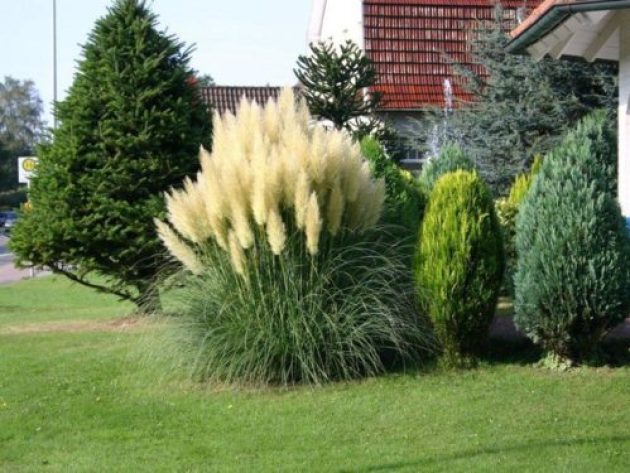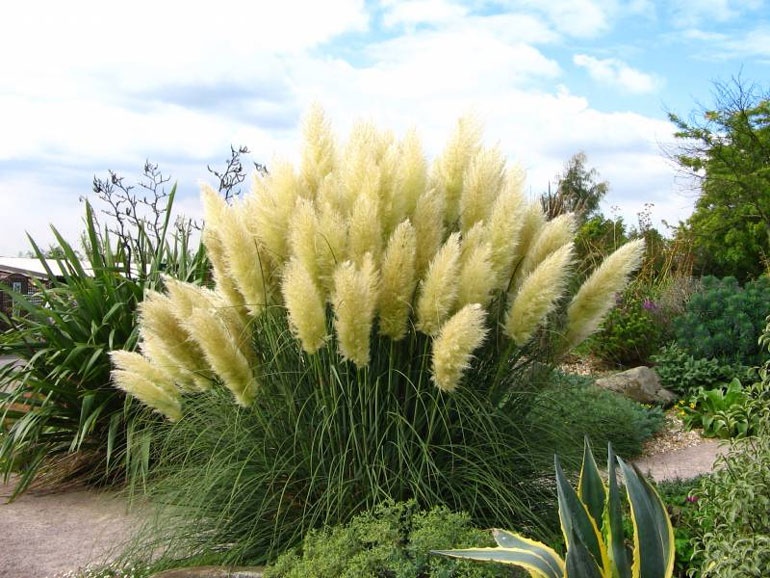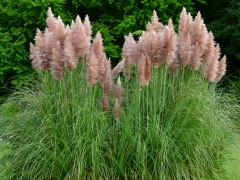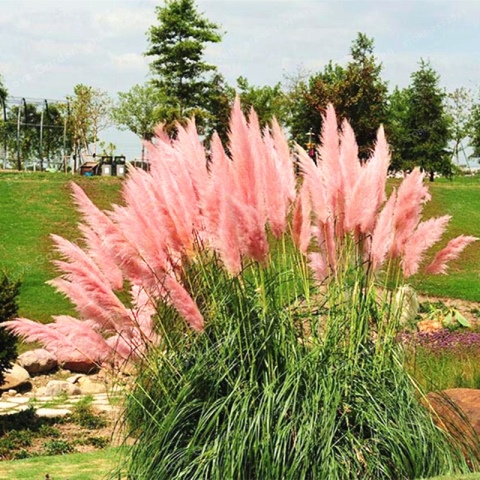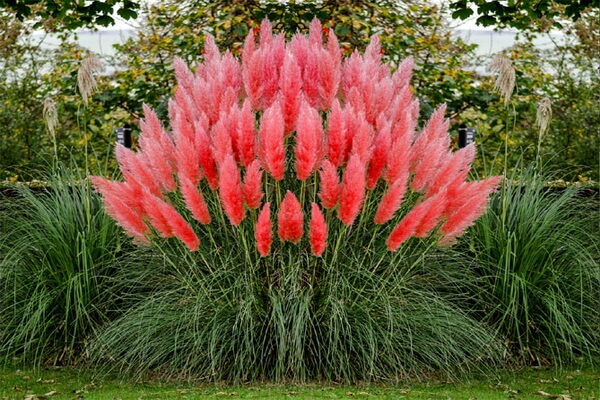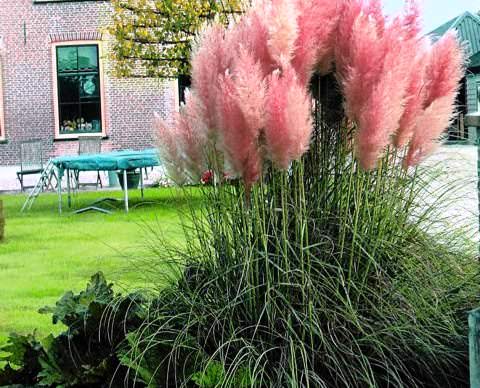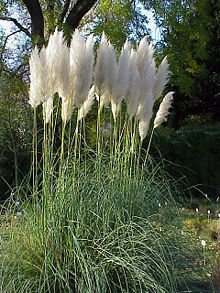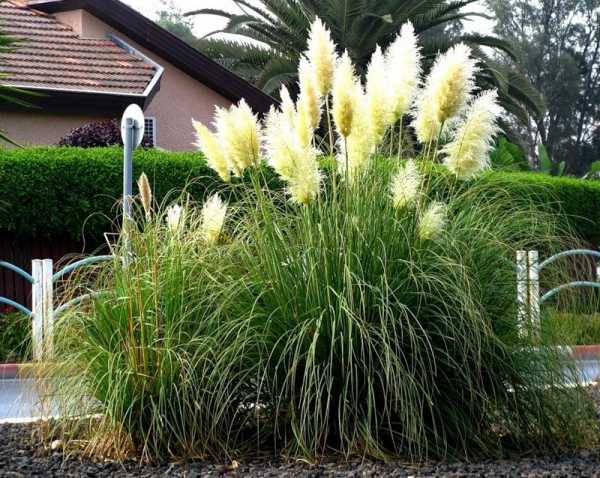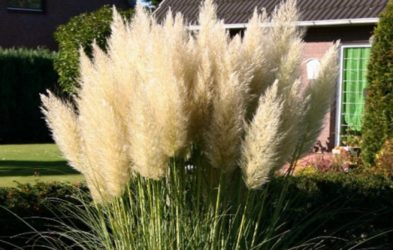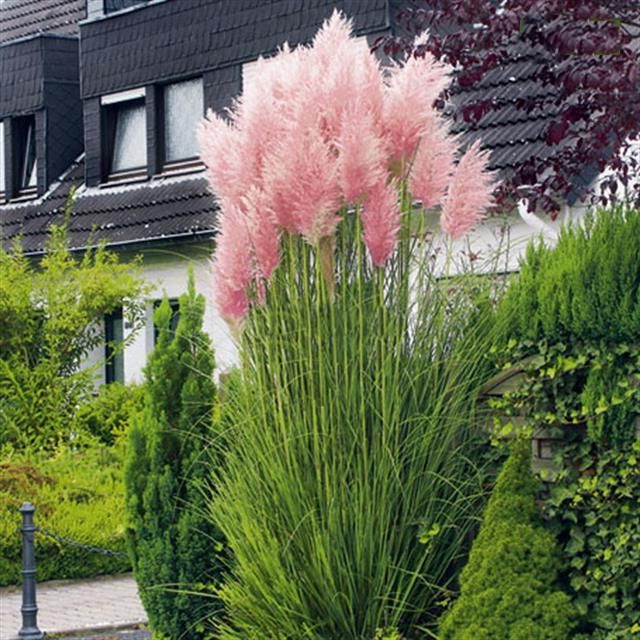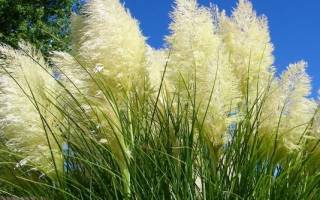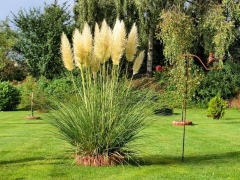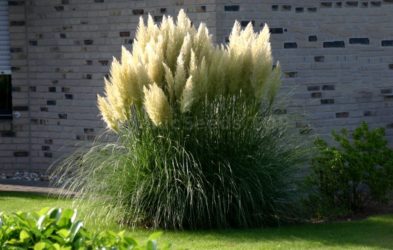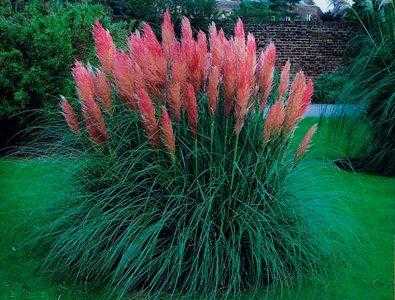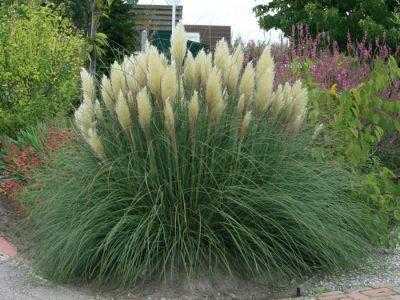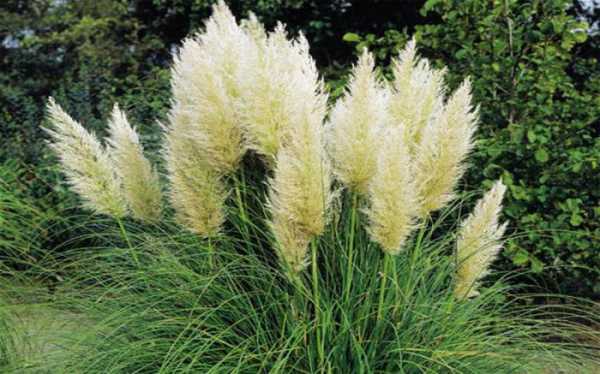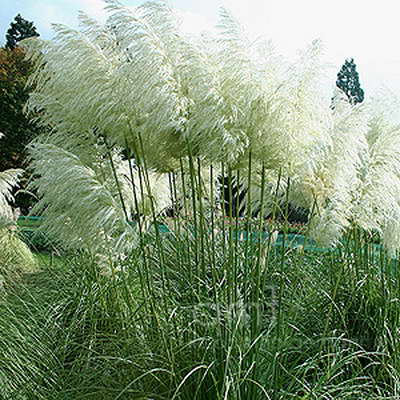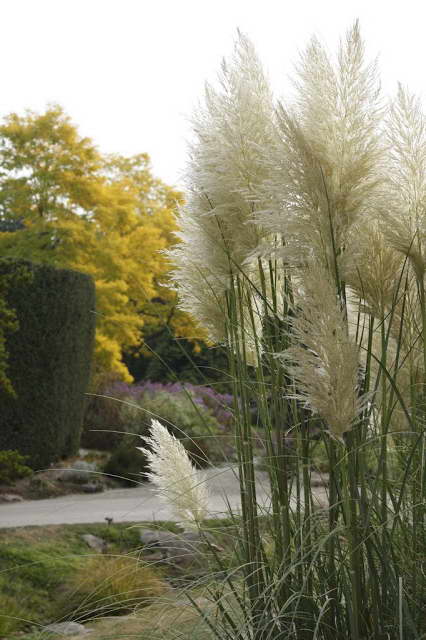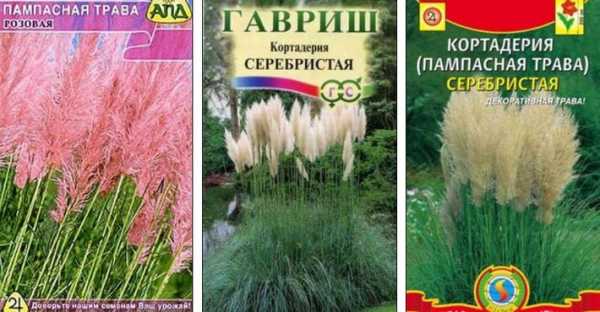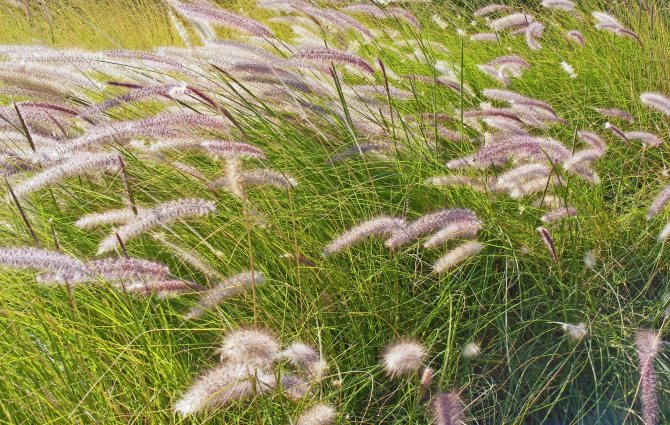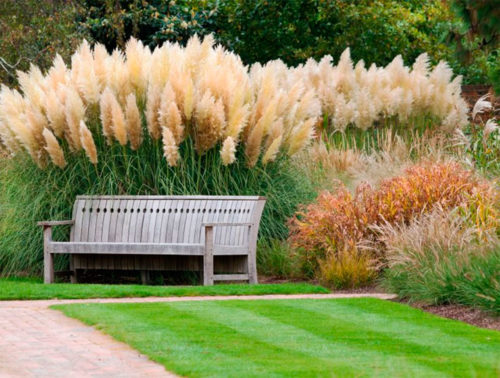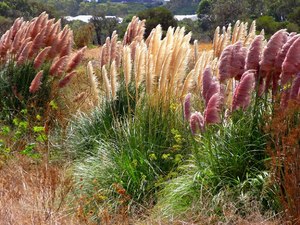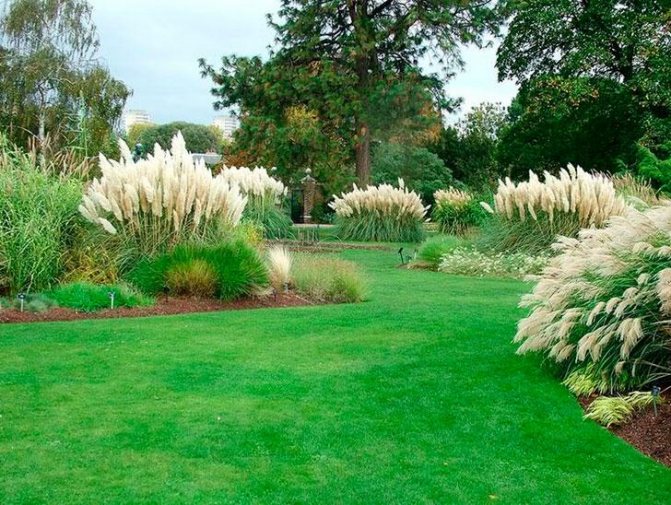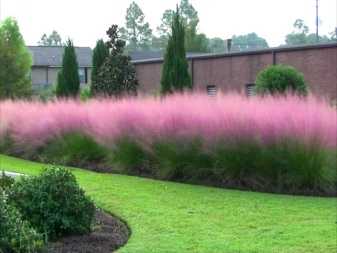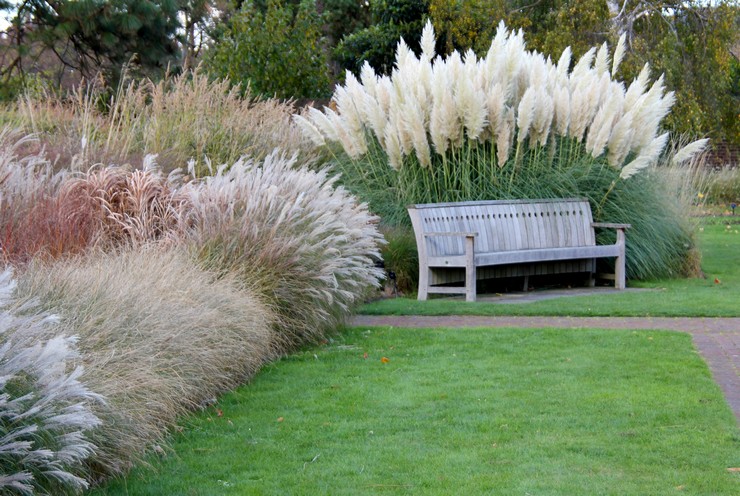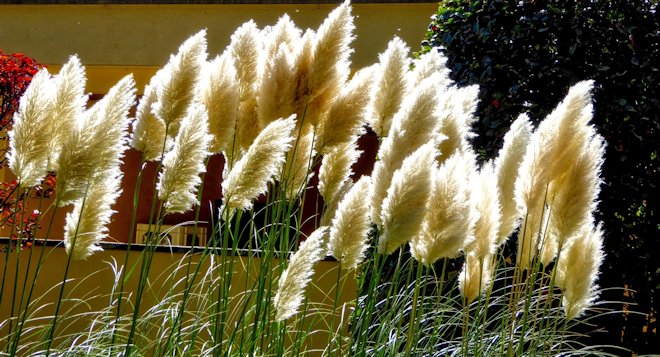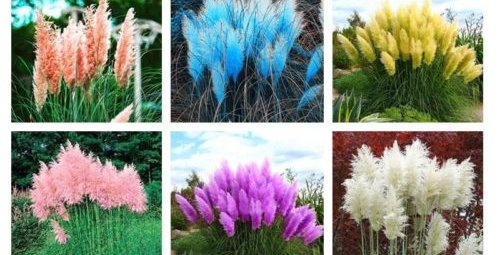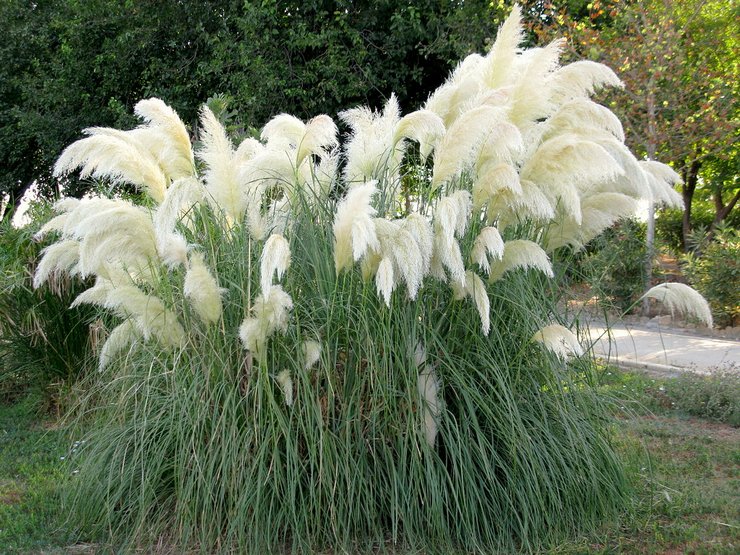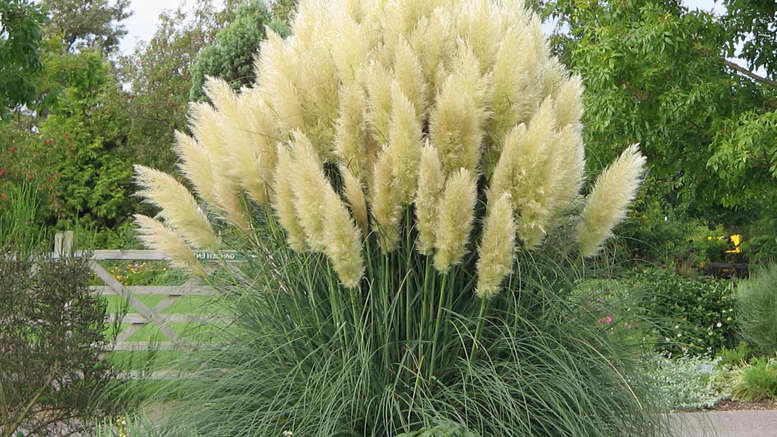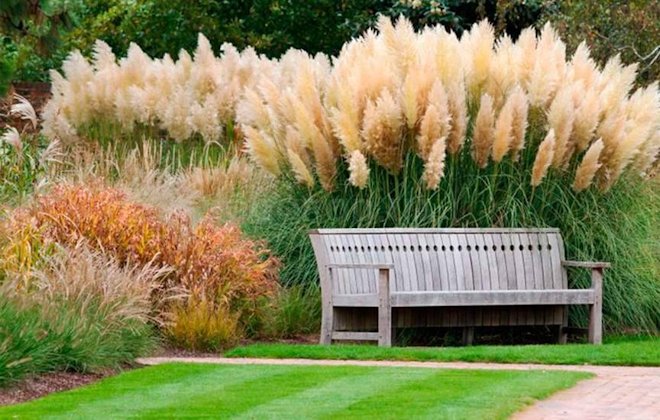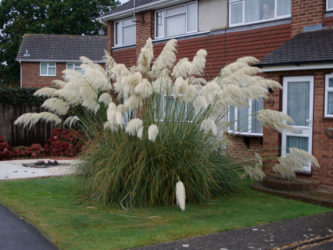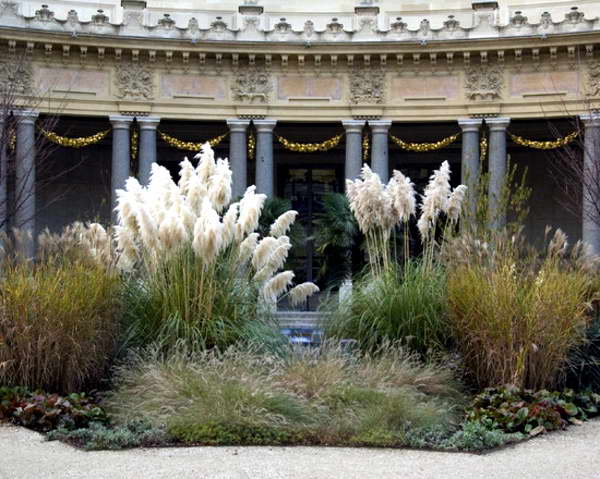Growing
Pampas grass, as befits a queen - demanding
It is important to know how to properly grow and care for a plant. Growing requires a lot of procedures, the bush loves the sun and well-permeable soil, and long preparations are required for wintering.
The grass is negatively affected by:
- cold winds
- excess moisture
- severe frost.
Therefore, growing grass requires many protective measures.
Attention! The edge of the leaf blade is covered with tiny, sharp teeth - it is easy to cut the skin with the leaves. Thick gloves are required for work
Watering
The cortaderia grass needs regular watering during the growing season. It is especially important to remember about irrigation during a drought. You need to water the plant, trying not to wet the leaves with water. It is necessary to ensure that there is no stagnation of water from watering, this leads to inhibition of flowering and even to the death of the plant. For these reasons, growing grass is quite difficult.
In rainy weather, in the cold season, it is advisable to equip a waterproof roof so that the soil under the plant dries out.
Fertilizer
It is important to systematically feed the cortaderia with nutrients rich in nitrogen, which will accelerate growth and flowering. Organic fertilizers are best suited - compost, which is spread out in a thin layer every year before the start of the growing season
It is advisable to regularly feed the plant before flowering, but it is important not to overdo it, because excessive fertilization interferes with normal growth.
Organic fertilizers are best suited - compost, which is spread out in a thin layer every year before the start of the growing season
It is advisable to regularly feed the plant before flowering, but it is important not to overdo it, because excessive fertilization interferes with normal growth.
Usually the grass is fed twice:
- the first feeding - in May;
- the second in July.
The complex fertilizer must be dissolved in water and the seedlings must be watered. In the spring, you can feed the grass with Azofoska every 3-4 weeks.
Wintering
Cortaderia in our climate often freezes, especially young seedlings. Overwintering pampas grass requires special protective measures. The best way is to tie the top shoots into a sheaf. It is best to hold the event when the grass starts to turn yellow. It is advisable to pre-cut the grass to a height of 30-40 cm. Sheaves of bound grass of bizarre shapes will give a charming look to the winter garden. The grass will then be safe and very decorative. She can scare off four-legged intruders who gnaw on the bark of trees in winter.
In order for the water to flow down the top of the sheaves, you need to tie all the leaves of the grass. It is also worth tying the bundles in several places, forming a tent-shaped bundle. You can throw a jute bag without a bottom over the plant, which is additionally filled with leaves. Leaves are harvested in the fall, dried in a dry, well-ventilated place so that they do not rot, do not rot
It is important that the leaves are dry and light when covered. Around the plant within a radius of 1 meter, the soil should be covered with a layer of dry leaves with a layer of up to 40 cm, sprinkling them with earth
In the spring, the leaves are removed. This is the best way to keep your grass overwintered.
To prevent water from getting into the mulch, it should be covered with foil.
In cold regions, for example, in the Moscow region, it is recommended to cover the plant additionally with straw or agrotextile and even make a roof over the bush. In this state, the grass hibernates without watering.
In regions such as Siberia, the Urals, the cultivation of cortaderia is very burdensome. Since, in addition to protection from frost, the grass loves long daylight hours.
The grass can be transplanted into a pot and moved to a safe place for the winter.For this it is worth choosing the undersized variety "Pumila" (Pumila). In winter, the plant is stored in bright rooms with temperatures up to 10 degrees Celsius. In early spring, the bush is taken out to the balcony, terrace, cutting off last year's leaves and inflorescences. The same is done with the cortaderia planted in the garden. However, the grass does not tolerate such an annual excavation, its root system is easily damaged. Therefore, the more recommended wintering method is planting in a large pot, which is easy to carry and store in a cool and bright room during the winter.
Diseases and pests
Uncut, old grass can become a habitat for insects (even wasps). In general, the plant practically does not get sick. The main thing is to avoid excess moisture, which causes damping and rot.
Cortaderia varieties with photos
To date, more than 25 types of cortaderia are known. At the same time, almost all species externally differ significantly from each other. However, they are united by high decorativeness and unpretentiousness. Only a small fraction of these species are cultivated outdoors.
Cortaderia selloana pink
The height of such a shrub can reach up to 200 cm.During flowering, it is decorated with fluffy inflorescences, which can be painted in various shades of pink: from bright pink to silvery pink (depending on growing conditions). In nature, the species is found in South America and New Zealand.
This plant looks like a dense thicket of ferns. The color of the leaves is greenish-gray with a bluish tint, while there are jagged edges on the edge. Long hairs of silver or white color grow around the flowering bush. Thanks to them, the cortaderia looks very unusual and impressive.
This species has many decorative varieties that differ from each other in the color of the flowers. As a result, such a plant is quite popular among gardeners.
Cortaderia silver
A distinctive feature of this species is the paniculate inflorescences of a silvery color. They rise 200-300 cm above the bush. Dark green leaves adorn strips of white or silvery shade, which are located along the edges of the plate.
This species is distinguished by its unpretentiousness, as well as the ability to quickly capture new territories. It is very difficult to get rid of the thickets of silver cortaderia. In order to prevent the strong growth of the bushes and preserve their decorative effect, they are systematically thinned out, and new roots are also pruned.
Cortaderia golden gold gang
The stems of such a vigorous perennial reach a height of about 200 cm. A characteristic feature of this species is a golden strip, which is located on the basal leaf plates. During flowering, white inflorescences are formed on the bush, decorated with whitish or silvery hairs. One inflorescence contains ten small flowers.
This species is also often grown by gardeners. And he fell in love with them because his unusual leaves and inflorescences retain their decorative effect throughout almost the whole year.
Cortaderia beige
This species differs from the rest in its short stature. Its inflorescences are light beige or pale yellow in color. The foliage is colored greenish-gray. For the winter, the foliage does not die off and retains its decorative effect throughout the year.
The rhizome of this species grows rapidly and gives new shoots. To limit the growth of the bush when growing in open ground, a special fence is installed around it
Those roots that go beyond the plant must be pruned, which is carried out very carefully.
White courtyard
In nature, this species can be seen infrequently. The top of its thick powerful stems is decorated with paniculate inflorescences of a milky or white shade, the length of which is about 0.3 m. The bush looks very impressive due to the unusual combination of lush panicles with golden-green or bright green foliage.Hair grows on female inflorescences, which add decorativeness to the plant.
Pampas grass care
Freshly planted plants need to be watered frequently. It is best to use a sprinkler that slowly but effectively moisturizes the soil. When the grass reaches two years of age, it takes root well, and if the summer is not too hot and dry, there is no need to water regularly. It is worth carefully observing the plant when it lacks moisture - it begins to fold its leaves. In this case, the plant must be well watered.
Mulching.
It will be good to cover the ground around the grass with mulch. It can be gravel, bark, shells, sawdust. Mulch will prevent the soil from drying out and play a decorative role.
Wintering of pampas grass.
In our climate, the grass needs protection for the winter. It is best to tie the shoots, wrap them with a film that protects them from moisture, and sprinkle the roots on a 20-30 cm layer of bark, leaves or sawdust. The whole structure must be reinforced with stakes
It is important that the plant has access to fresh air, so the shelter cannot be too dense.
Pampas grass after winter
Pruning is required in the spring. The procedure must be performed shortly before the start of the growing season. The stems are cut as low as possible from the ground with pruning shears or scissors. All cut out stems are carefully collected with a rake and transferred to a compost heap or finely chopped and left as mulch. To make cutting easier, you can tie up old shoots with a rope and cut them close to the ground.
The pampas grass leaves have sharp edges, so you need to be careful not to cut yourself. Better to wear gloves. Some remove the dried out bush by making a small fire in the middle so that last year's shoots are burned
However, care should be taken not to destroy the entire plant.
Interesting: Andalusian horse - breed description, photo
Courtyardia in landscape design
Cortaderia pampas grass silvery in landscape design photo
Cortaderia bushes look most impressive in open spacious areas. Pampas grass is used to create a hedge, as a background for a mixborder, it can be planted as a salt among trees, combined with shrubs.
Courtyardia in landscape design photo
The framing of reservoirs with thickets of cortaderia is a spectacle of striking beauty. Favorably emphasized by rocky gardens with large boulders.
Courtyardia in the design of a summer cottage photo
Combine with tall light-loving plants: verbena, yarrow, crocosmia, milkweed, cosmea, artichoke, rudbeckia, echinacea, perovskaya, with other herbs and ornamental grains.
Cortaderia Sello Pink Pampas Grass Pink Pink Pampas Grass - Cortaderia selloana Rosea
Cortaderia selloana Rosea
Rosea (Pink) - reaches a height of 2 m. Panicles have inflorescences of a silvery-pink hue.
Cortaderia pink color smoky pink variety Rendatleri photo
Interesting variety Rendatleri with ash-pink inflorescences.
Cortaderia sello pink pink variety Cortaderia selloana Pink Feather photo
Pink Feather - bushes about 2 m high with pinkish inflorescences, green-gray leaves.
Cortaderia Silver
Cortaderia Silver Cortaderia Sunningdale Silver photo
Sunningdale Silver - inflorescences have a silvery shade.
Cortaderia silver Silver Stripe photo
Silver Stripe is a two-meter bush with white-silvery inflorescences, variegated leaves: there are silvery-white stripes along the edges.
Cortaderia beige
Cortaderia beige Pumila photo
Pumila - height is about 1.5 m. Inflorescences are yellow-silvery.
Courtyardia Sello Patagonia Patagonia photo
Patagonia - reaches a height of 2 m, the inflorescences are beige-silvery, the leaves are gray-green.
White courtyard
Courtyardia white Splendid Star photo in the garden
Splendid Star - the height of the bush is limited to 1.5 m. The panicles are milky white, the leaves have a golden green hue.
Cortaderia sello white cultivar Cortaderia selloana - ‘Monstrosa’ photo
Monstrosa - the height is 2 m, the leaves have a bluish tint, the inflorescences are white, with long drooping silky strands.
Cortaderia varieties
More than 25 varieties of cortaderia are known. Each species is attractive and has different properties and descriptions. However, only a few types of pampas grass are cultivated.
Cortaderia sello pink pampas grass pink pink pampas grass cortaderia selloana rosea
Tall shrub reaching 2 meters with delicate pink inflorescences. Panicle shades can range from silvery pink to deep pink, depending on growing conditions. In its natural environment, it is distributed in New Zealand and South America.
The perennial bush resembles dense thickets of ferns. The foliage is gray-green in color with bluish tints. The edges of the leaf plates in the variety are serrated. Long white or silvery hairs are formed around the perennial during the flowering period, which give an unusual decorative appearance to the shrub.
Various varieties of cortaderia sello pink have interesting shades of flowers, which leads to the widespread use of this species in landscape design.
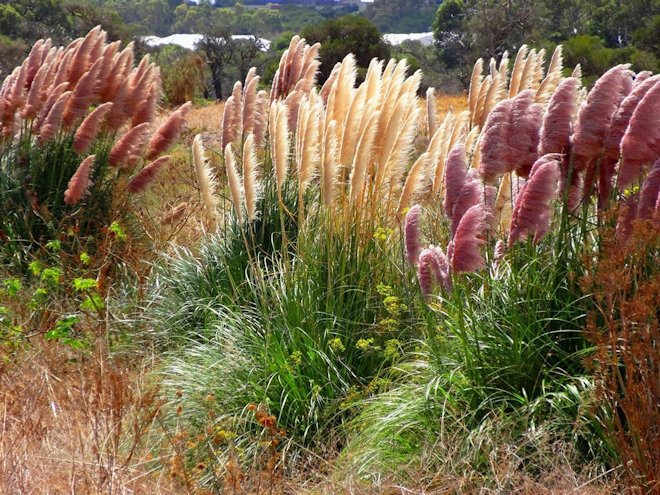
Cortaderia silver cortaderia silver
A feature of the variety are silvery panicles, which rise 2-3 meters above the grass. The leaves of the shrub have dark green shades. At the edges of each sheet you can see silver or white stripes, which gives the cortaderia an extraordinary look.
This variety is unpretentious in cultivation, grows quickly and creates thickets of shrubs that are difficult to remove. When growing silver cortaderia in the garden, it is necessary to regularly thin out and prune new roots in order to maintain the appearance of the bush.

Cortaderia golden gold gang gold band
Tall plant, reaching 2 meters on the stem. A feature of the variety is the presence of a strip of golden color on the basal leaves. The plant blooms with white flowers covered with silvery or white hairs. One inflorescence has 10 small flowers.
This variety is also used in cultivation. The extraordinary beauty of the foliage and inflorescences allows you to enjoy the cortaderia all year round.
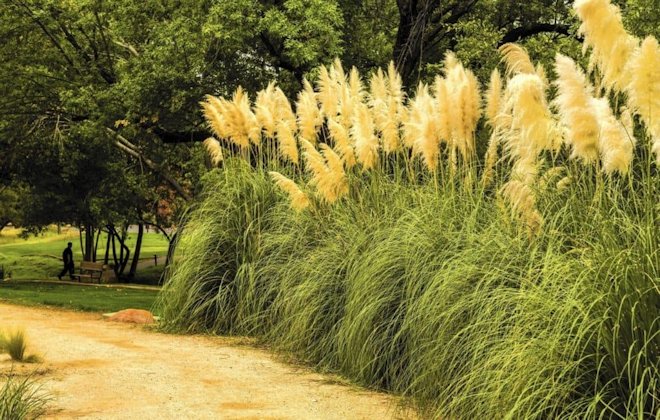
Cortaderia beige
Low compared to other plant species. The pampas grass of this variety has light yellow or beige hues. The leaves of the variety are gray-green in color. Herbaceous leaves do not fall off in the winter, remaining in their form all year round.
The rhizome grows rapidly and gives rise to new shoots. Therefore, when growing in a park or garden, it is worth making a fence around the bush. Roots extending outside the bush are carefully trimmed.
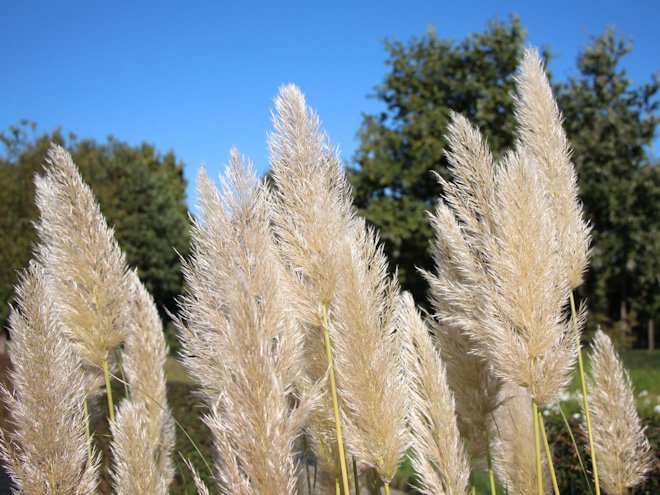
White courtyard
In the natural environment, it is quite rare. The majestic appearance of the white cortaderia is due to the thick stem, on which there are white or milky panicles up to 30 cm in height. The fluffy inflorescences of this variety are combined with rich green or golden-green hues of the basal grass. On each female inflorescence of this species, hairs are visible that adorn the plant.
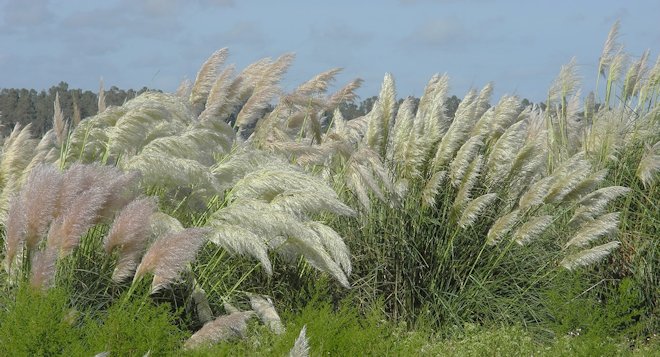
Pampas grass, varieties and varieties
As an ornamental plant, pampas grass was known in Europe as early as 1837, when the unusual cereal was planted in the gardens of Queen Victoria.
Currently, breeders have bred more than 25 species of perennials and twice as many varieties of cereals.
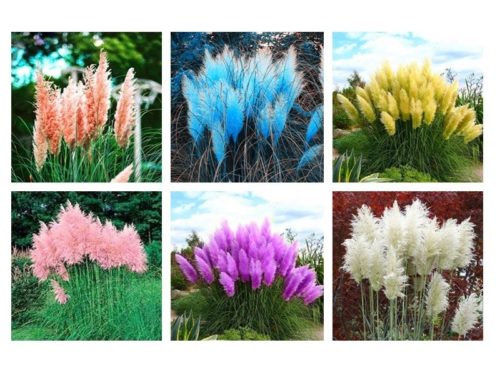
Classifying the cortaderia by the color of the inflorescences, the following varietal groups of the plant can be distinguished.
Pampas grass varieties with white and silvery buds
- Variety "Pumila Sunningdale Silver" grows up to 3 m, "throws out" tall peduncles with silvery inflorescences.
- Variety "Monstrosa" reaches a height of about 2.5 - 3 m, has large whitish inflorescences with a slight shade of yellow, the leaves are bluish-green.
- Variety "Patagonia", up to 2.4 m high, with silvery-yellowish inflorescences.Blooming later, the leaves have a beautiful bluish tint. Cold-resistant variety.
- Variety "White Feather" grows no more than 2 m, blooms with whitish lush inflorescences.
- Sort "Silver" is a relatively short grass, 1.5-2.1 m high, has cream inflorescences, flowering occurs early.
- Variety "Senior" reaches a height of about 1.8 m, has whitish inflorescences.
- Evita variety - from 1.2 to 1.7 m, with silvery-yellowish inflorescences. It is characterized by early flowering.
- Variety "Lilliput" is a low-growing variety of pampas grass, growing no higher than 1-1.5 m. It is distinguished by white inflorescences and gray-green leaves.
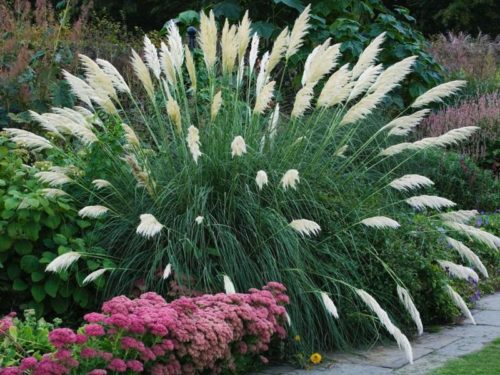
Pampas grass varieties with pink inflorescences
- Sunningdale Silver Highfield Pink is a tall variety reaching 2.5-3.5 m and blooms with delicate pale pink inflorescences.
- The variety "Carminea Rendatleri" reaches a height of 2.5-3.6 m, has pink inflorescences and straight tall stems.
- Variety "Scarlet Wonder" grows in height up to 2.5-3 m, has red inflorescences.
- Variety "Rendatleri" is characterized by beautiful lilac inflorescences, plant height 2.5-2.7 m.
- Variety "Pink feather", "Rose Feder" grows no higher than 2.5 m, blooms with pink inflorescences.
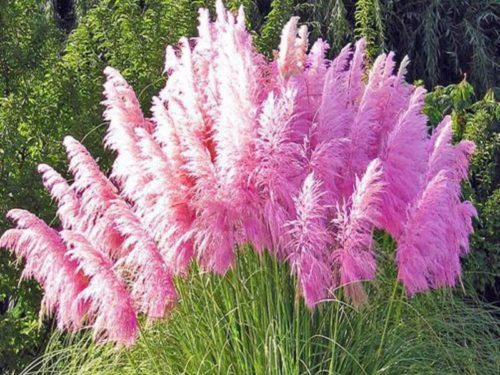
Varieties of pampas grass with whitish striped leaves
- Sort "Silver Comet" grows up to 2.5 m, "throws out" silvery inflorescences and creamy striped leaves.
- Variety "Notcort" reaches a height of about 2 m, is distinguished by creamy white narrow leaves.
- The Albolineata cultivar is 1.5-2 m high, the light color of the foliage is bordered by a white edging. The variety is characterized by relatively slow growth.
- The Ice Cool variety is a relatively low variety of cereals (1.5-1.8 m), late blooms, leaves with whitish fields.
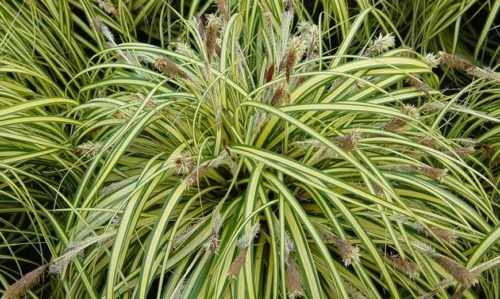
Pampas grass cultivars with yellow striped leaves
- The variety "Golden Goblin" reaches a height of no more than 1.5 m, blooms early, with white flowers. The leaves are decorated with a central yellow stripe.
- The "Movin" variety grows in the range of 1.2-1.5 m, the inflorescences are silvery-whitish, the leaves are white with a yellow stripe in the middle.
- Variety "Golden Fantasy" - one of the smallest (1-1.5 m), silvery inflorescences, leaves are light, with yellow edges and stripes.
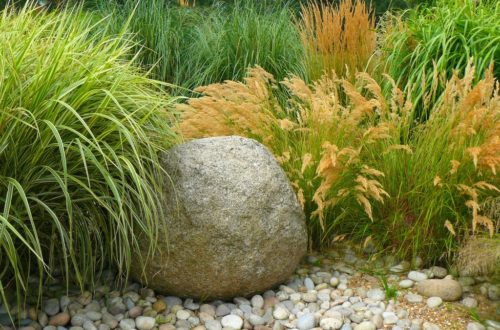
Where to get pampas grass?
You can buy pampas grass in any specialty store, plant nursery or proven online sale. Cortaderia planting material can be sold as seedlings or perennial grass seeds.
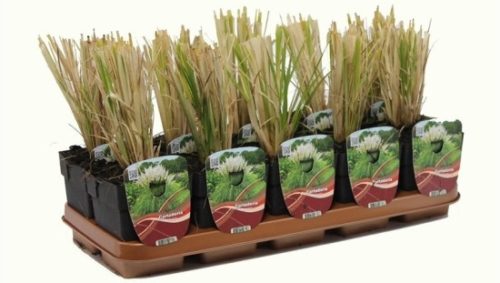
When purchasing seedlings of cereal crops, you should pay attention to the sexual form of the proposed plant. Female specimens have an increased decorative effect, which they do not lose even during the rainy season. Male plants are distinguished by looser panicles, which noticeably fade and lose their attractiveness with the onset of autumn.
Buying cortaderia seeds can not always 100% guarantee the sex and variety of the plant.
According to the reviews of many gardeners, the pampas grass is absolutely not a capricious plant, which quickly takes root in a new place.
Male plants are distinguished by looser panicles, which noticeably fade and lose their attractiveness with the onset of autumn.
Buying cortaderia seeds can not always 100% guarantee the sex and variety of the plant.
According to the reviews of many gardeners, the pampas grass is absolutely not a capricious plant, which quickly takes root in a new place.
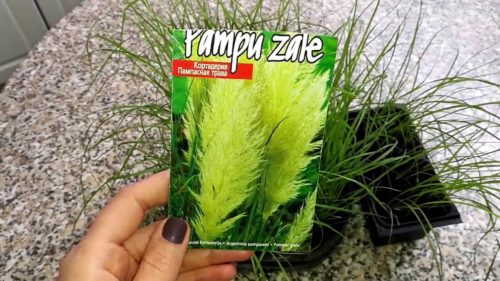
Transfer to a permanent place
Before growing a silver cortaderia or another variety from seeds, a suitable site is selected and the soil is prepared.
Place and soil
The plant is not picky about the type and fertility of the soil, the temperature regime and the level of illumination. However, in drought conditions on depleted soil, the culture loses its decorative qualities and stops flowering.
To preserve decorativeness, it is worth considering the following:
Pampas grass prefers sunny places: an abundance of light will have a positive effect on spreading.
Like all reeds, it is better to develop in moist soil, although it will not die in extreme heat.
Particular attention is paid to the moisture permeability of the soil: in swampy areas, the plant stops developing.
Garden bed preparation
Prepare the site in advance:
- digging up the ground;
- humus or peat is added if desired;
- remove weeds.
The day before planting, planting holes are dug according to the size of the root system. Coarse sand is laid out at the bottom for soil drainage.
Transplanting
The sprouts are transferred with a lump of earthen into the prepared holes. Then they are covered with soil, compacted and watered.
When transplanting, follow these rules:
- the root collar is slightly deepened - this will protect the grass from freezing in winter;
- the distance to the nearest crops is left at least half a meter - under optimal conditions, the cortaderia forms a large, spreading bush, which, if located close, will interfere with the development of other plants.
Culture care
Pampas grass will delight you with spreading and lush flowers, if you provide it with minimal care, which consists in the following actions:
- Watering: in the first year of cultivation, they are moistened 2-3 times a month, in subsequent years - it can be less often, during a drought they are watered weekly.
- Feeding: complex fertilizers are applied every spring.
- Pruning: in the spring, dry foliage is removed, the middle of the bush is thinned out, dry inflorescences are cut out.
The benefits of growing South American weed include disease and insect resistance. In rare cases, lesions are possible:
- powdery mildew, anthracnose: you need to cut out the infected areas and treat with a fungicide;
- spider mites (in drought), aphids: when they appear and for prevention, plants are treated with insecticides.
Rapid growth is considered a significant drawback: if the grass is not limited in growth, it will fill the entire area. And it will be difficult to fight it. Another drawback: growing Cortaderia from seeds will allow you to get the grass of the desired shade, but the first flowers will appear only after 5 years.
When working with a plant, one should not forget about caution: thin and tough leaves can injure the skin. Therefore, it is not recommended to plant it next to children's areas and paths.
Cortaderia silvery how to grow from seeds
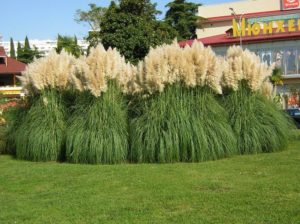
I have already grown silvery cortaderia from seeds twice and now, finally, I found time to share my experience. Both times I bought seeds of pampas grass (as this decorative cereal is called in another way) from the agricultural firm Gavrish. There are not very many seeds in a package - 0.01 g (about 15 pieces).
The seeds are thin, elongated, rather small for such a large plant, although, of course, not as small as those of ever-flowering begonias or lobelia. I sowed the seeds in a plastic container for the salad (with a lid), and used the universal “Exo” soil.
For those who have little experience in growing seedlings, I will tell you in more detail.
First, pour the soil into a container and water it well. Then we spread the seeds over the surface. We fill them with a thin layer of substrate (literally 3-4 mm) and moisten them from a spray bottle.
If you put the seeds on dry soil, fall asleep, and then water, then there is a high probability that they will slip to the bottom along the side walls and will not be able to break into the light.
Now cover the seeds with a transparent cover so that you don't have to worry about soil moisture before they germinate.
The first shoots of the cortaderia appeared on the 12th day. The cover must be removed immediately. They look like thin threads. Cortaderia silvery is a monocotyledonous plant (the Bluegrass family), so one leaf comes out, and not two cotyledons, as in most garden plants.
You can dive seedlings into separate cups when they have about 3 real leaves. The picking process is shown in the photo below.
Picking of seedlings of silver cortaderia (pampas grass)
The first time I grew a cortaderia from seeds for my mother's garden.The sown seedlings were planted in the open ground at the beginning of June. By autumn, the plants formed rosettes of long, arcuate curved leaves. Their height was about 50 cm. It was in the Lipetsk region. After the onset of stable autumn frosts, we cut off the cortaderia, covered it with humus and covered it with sackcloth.
This year I am growing seedlings of cortaderia for myself, I will sell the surplus. The plant is large, I have ten growing up, for my garden this is too much. After all, the pampas grass during flowering (from August to October) reaches two meters in height. And no less in diameter.
Silver Cortaderia is light-requiring and drought-resistant, prefers fertile soils, although in general it is not too demanding of them. Pampas grass can not only be grown from seeds, but also propagated by dividing the bush (sod). I really love decorative cereals, I already have feather grass, fescue, miscanthus, I think the cortaderia will perfectly fit into their company.
Cortaderia or pampas grass for a summer cottage How to grow from seeds Planting and care Photo
Cortaderia selloana or pampas grass is a perennial herb of the Grain family (Bluegrass). It is grown exclusively for decorative purposes. When favorable conditions are created, it reaches a height of 2.5-3 m - the bush rises monumental in its summer cottage.
The leaves are lanceolate, very long, located at the root with a lush shock, have an elegant bend. They are tough, have a green matte shade, there are varieties with a longitudinal stripe of white or cream color.
On the tops of thin but strong peduncles there are fluffy paniculate inflorescences that are not afraid of cold weather or snow, decorating the garden all year round. The colors are very bright: pink, lilac; golden panicles look no less impressive.
Courtyardia in park design photo
Dense thickets of pampas grass sway in the wind, creating an atmosphere of calm and harmony.
The name of the plant is derived from the Spanish word cortar - to cut. This is due to the sharp edges of the plant's leaf plates. In the natural environment, cortaderia is widespread in the steppes of South America (pampas) and on the Pacific islands. Due to its origin, the plant received a second name - pampas grass.
general description
Names:
- pampas grass;
- cello cortaderia;
- the cortaderia is dioecious;
- queen of the steppes.
Family: cereals.
Where it grows:
- in the wild - in South America, mainly in the steppes in its southeast - in the pampas (hence the name);
- as an ornamental plant, it is grown in various regions around the world, where the summer is warm.
Note. In the northern regions, pampas grass cannot be grown as an ornamental plant in the open field. Summer is too cold and short for her. Her panicles do not have time to fill with color.
Botanical Description:
- herbaceous dioecious plant;
- height - up to 3 m;
- forms dense turf (bushes, hummocks);
- leaves are lanceolate, tall (up to 2 m in length), thin (no more than 1 cm in width), evergreen (do not turn yellow even in winter), rough, with sharp tips (you can prick), bluish-green or silvery-gray;
- flowers - in the form of panicles (up to 40 cm in length) of various shades: white, silvery, yellow, pale pink, carrot, red, purple, purple and even blue;
- panicles - can hang down like a fox's tail or be erect, like candles;
- peduncle - high arrow (up to 3 m in length);
- flowering - August-November, but the panicles remain dry and in winter, which makes it possible to use pampas grass in beds of continuous flowering;
Perennial or annual? Cortaderia is a perennial plant.
Is it poisonous or not? No, neither flowers, nor leaves, nor stems, nor roots contain any poisonous and life-threatening substances.
Usage:
- most often grown as ornamental grass, less often as fodder for livestock;
- dry fluffy panicles are used as decoration and components of Ekibana.
Growth features:
- unpretentious, easily adapts to climatic conditions and soil;
- only some varieties are frost-resistant;
- afraid of cold winds and excess moisture;
- in a warm climate produces a huge amount of seeds (during life - up to 1 million);
- burning and digging does not help remove the pampas grass, the only way to do this is chemical weeding.
Due to this growing pattern, in California, Spain and Hawaii, pampas grass is considered a weed. For this reason, it is prohibited to sell or distribute it in South Africa and New Zealand. Despite its unpretentiousness, in central Russia it is not always possible to wait for brooms from it, if the summer is cold and rainy. She simply does not have time to dial in color.
Planting and care in the open field
Cortaderia belongs to unpretentious plants. It grows and develops equally actively on different types of soil. The culture tolerates drought and bright light well. Since the curtains are quite high and wide, it is necessary to plant the plant in a spacious open area. You should not worry that Cortaderia may suffer from drafts or strong gusts of wind, since, despite the tall inflorescences, she is not afraid of them.
Although Cortaderia tolerates drought, it responds favorably to watering. If the weather is dry and there is no rain, it is recommended to water the curtains every two weeks. Pampas grass does not really need feeding. Just one top dressing in the spring is enough.
The plant is resistant to diseases and pests, so in this regard, the plant also does not cause trouble.
Pruning is a must, although it is not so easy to carry out due to the large size of the plant, thorny and hard leaves. Yellowed leaves are removed annually, which thicken the center of the thickets.
When planting seedlings of Cortaderia in open ground, it is recommended to deepen the root collar a little - this will allow the plant to better endure the winter cold.
To prevent the plant from freezing in winter, in late autumn its stems and leaves are tied into a dense bundle and slightly pressed to the ground. You can cut off part of the growth to a height of 50-60 cm from the ground. The rest of the shoots must be covered with spruce branches or non-woven covering material.
Kortaderia looks beautiful in landscape design

